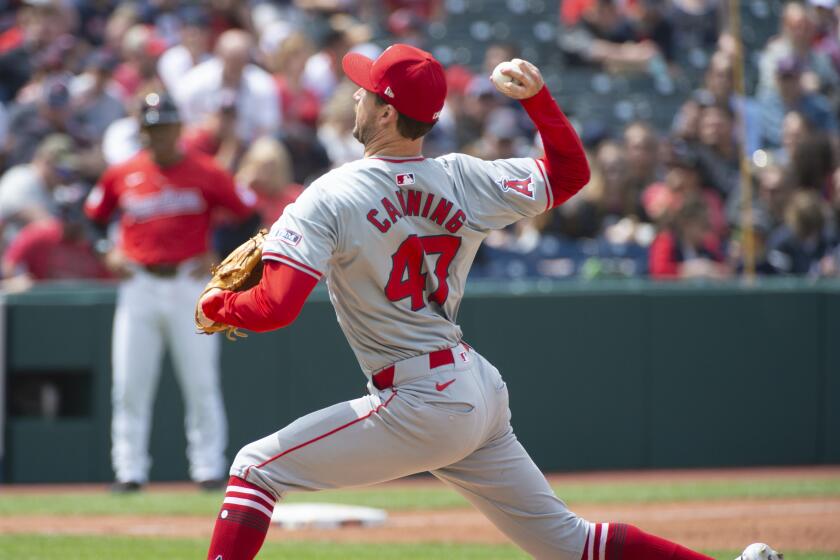PRO FOOTBALL / BOB OATES : These Two Receiving a Lot of Attention
For one of the few times in this century, two Los Angeles wide receivers could both be Heisman Trophy vote-getters this year and, eventually, first-round choices in the NFL draft.
Johnnie Morton of USC and J.J. Stokes of UCLA keep impressing pro coaches as well as college opponents for reasons that are plain to football fans as well: Morton’s hands and agility and Stokes’ size and play-making skills.
NFL scouts don’t like to compare them because Stokes is a junior. And that remains a sensitive area.
The pros never want juniors, they say, and it pains the colleges to lose them--in spite of which it happens every year.
The consensus of NFL scouts in three sections of the country:
--Although San Diego State’s performance this fall has taken running back Marshall Faulk out of the Heisman race, he remains the West’s ablest prospect.
--When Morton and Stokes are drafted, they will probably go in the lower half of the top round, Morton next April, and Stokes a year later, the Bruin’s advisers predict.
The one pro who agreed to talk about them publicly is Dick Steinberg, general manager of the New York Jets.
“We don’t scout juniors, but in (UCLA games) you can’t miss Stokes,” Steinberg said. “He’s a big guy with a long stride, so you don’t know how fast he is. Long striders look slower than they are.
“Morton has everything you want in a receiver except blazing speed. He’s faster this year, he is exceptionally sure-handed, he is a clever, acrobatic athlete who nonetheless runs disciplined routes, and he runs well after the catch.”
But not as effectively, Steinberg said, as Curtis Conway.
The seventh college player drafted six months ago, Conway, a USC sprinter, was the top pick of the Chicago Bears.
An ankle injury delayed Conway until two weeks ago, when, as the Bears upset the Philadelphia Eagles, 17-6, he caught three passes for 48 yards, one for a touchdown on a big play. He caught two for 17 Monday against the Minnesota Vikings, when two of his plays set up half of Chicago’s points in a 19-12 defeat.
If Morton is the second USC receiver in two years to become a first-round draft choice, it won’t surprise the Trojan fans who watched the pair compile a unique set of statistics a year ago. Each had 49 catches--Conway for 764 yards and Morton for 756--in a season when Conway’s long gainer was 61 yards, Morton’s was 65.
To win a prominent place in the first round, a pass receiver needs Conway’s kind of great speed, meaning that Morton won’t be drafted that high.
But very often, slower receivers develop into more useful NFL players, the scouts say, mentioning former star receivers Steve Largent of the Seattle Seahawks and Drew Pearson of the Dallas Cowboys.
One obvious difference between Morton and Stokes is size. A 190-pounder who stands 6 feet, Morton is towered over by Stokes, 6-5, 214.
If the pros, when they see Morton, think of Largent or Pearson, they compare Stokes to the few big receivers in the NFL today: Detroit’s Herman Moore, 6-3, 210; the Jets’ Rob Moore, 6-3, 205, and the two at Dallas, Michael Irvin, 6-2, 199, and Alvin Harper, 6-3, 207.
Because most NFL cornerbacks stand 5-10 or thereabouts, tall receivers have a built-in edge, as Irvin proves nearly every Sunday.
There’s an edge, that is, if the tall receiver is as quick and fast as Irvin. That is what the pros aren’t sure of yet when they see Stokes. UCLA’s coach, Terry Donahue, won’t let the pros measure him.
To the rest of us who watch Stokes running with the ball in a broken field, he resembles a younger Eric Dickerson, and it was speed that made Dickerson.
More to Read
Get our high school sports newsletter
Prep Rally is devoted to the SoCal high school sports experience, bringing you scores, stories and a behind-the-scenes look at what makes prep sports so popular.
You may occasionally receive promotional content from the Los Angeles Times.






